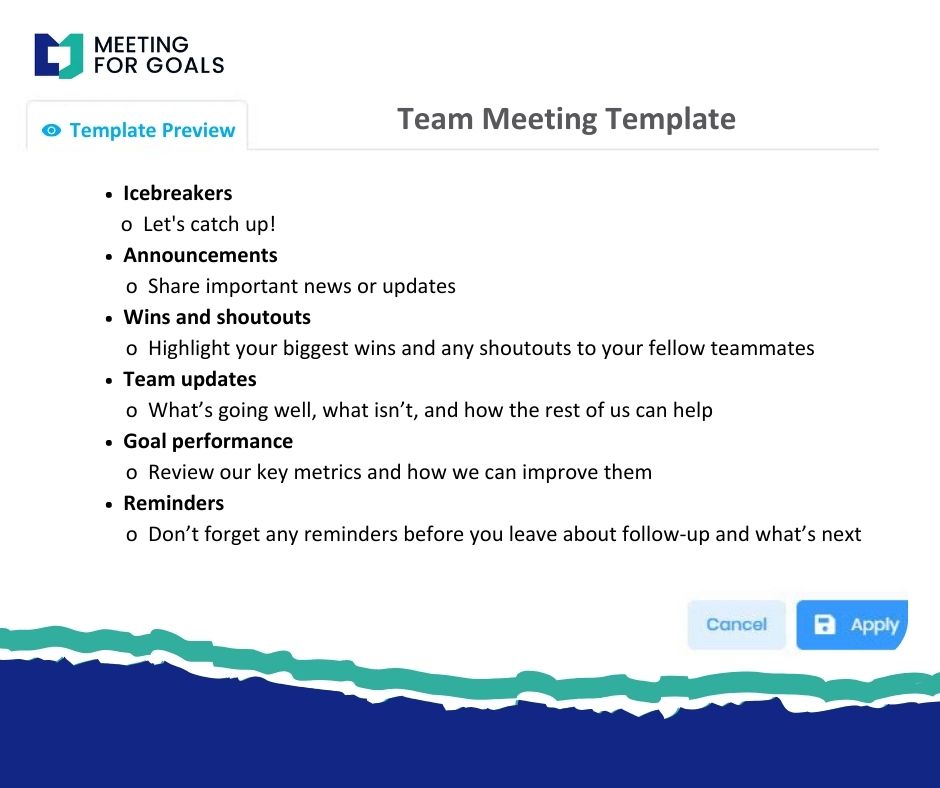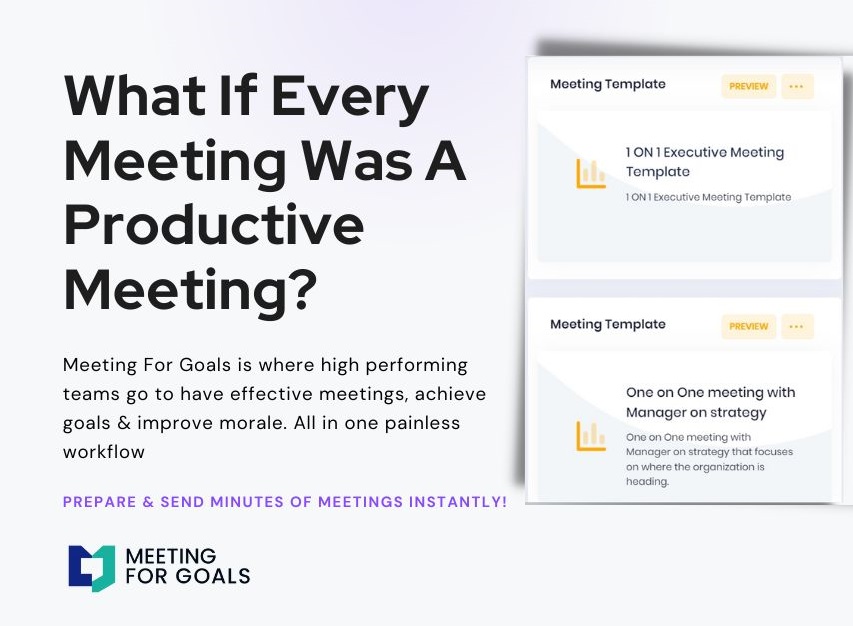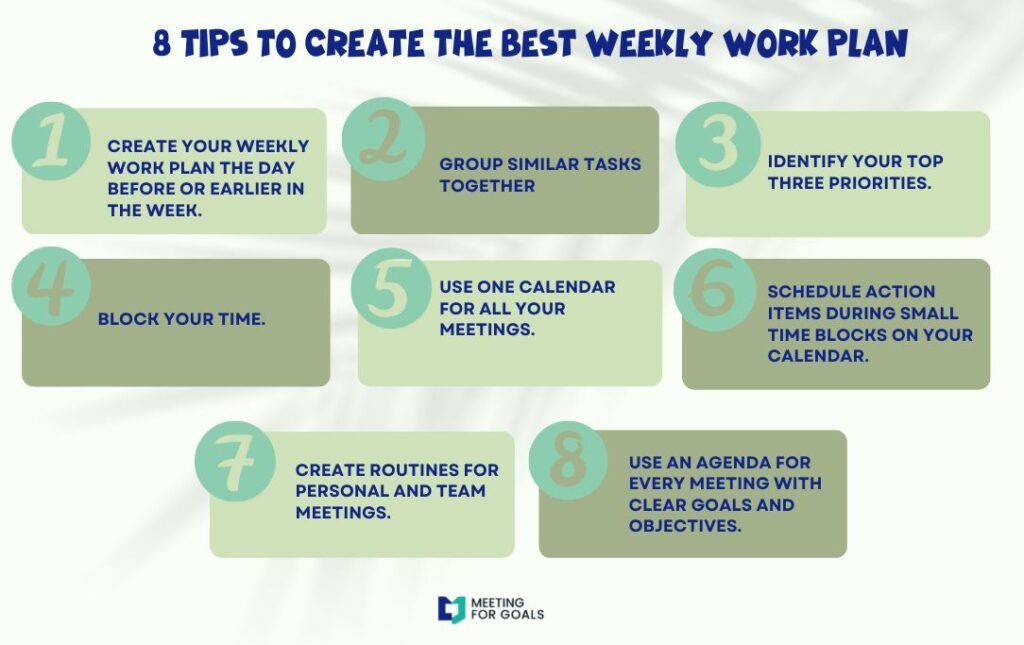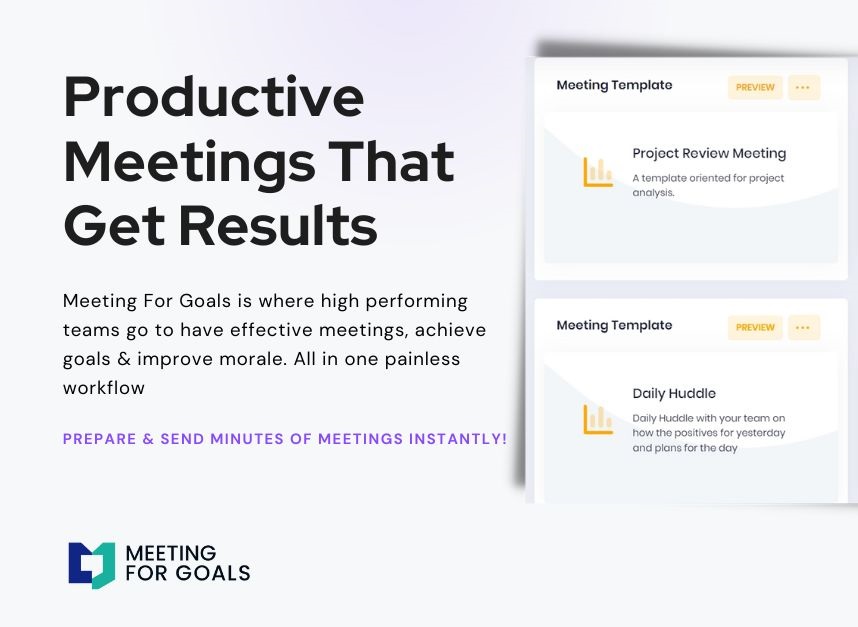Mastering 1 on 1 Meetings: A Guide for High-Performing Teams
Excerpt:
In today’s fast-paced business world, clear and consistent communication between managers and their teams is more important than ever. One of the most effective ways to build alignment, boost accountability, and increase employee engagement is through regular 1 on 1 meetings. But without the right structure and tools, these meetings can become disorganized or even forgotten. This guide will walk you through how to run powerful 1 on 1 meetings, best practices to follow, and how Meeting For Goals can help streamline the process. Whether you’re a VP, Director, or C-suite leader managing a team of 40–70 people, you’ll find actionable insights to turn your 1 on 1s into a key driver of team success.
I. Introduction
Effective communication is the lifeblood of any successful organization. When it comes to building strong relationships, giving feedback, and aligning on goals, 1 on 1 meetings stand out as one of the most powerful tools in a leader’s toolkit.
For mid-sized teams, especially those navigating growth, these meetings are essential. They only work when they’re consistent, focused, and well-executed.
That’s where Meeting For Goals comes in. Our platform makes it easy to create structured, goal-driven 1 on 1s that keep everyone aligned and moving forward. You can start today by signing up at https://app.meetingforgoals.com/TenantRegistration/Register.
In this guide, we’ll cover:
- What 1 on 1 meetings are and why they matter
- Best practices for conducting effective 1 on 1s
- How to structure and prepare for each meeting
- The importance of follow-up and accountability
- How Meeting For Goals can enhance your meeting process
Let’s get started.
2 Minute Video
Watch a 2 minute demo of our meeting management software in action
II. Understanding 1 on 1 Meetings
A. What Are 1 on 1 Meetings?
1 on 1 meetings are private, recurring conversations between a manager and their direct report. Unlike team meetings that focus on project status or group updates, 1 on 1s are personal and individualized.
They’re a chance to talk about performance, growth, challenges, and anything else that impacts the employee’s success. Most teams hold them weekly or bi-weekly, and they usually last between 30 to 60 minutes.
These meetings are your opportunity to connect, coach, and collaborate. Done right, they build trust and drive performance.
B. Why 1 on 1s Matter
The benefits of regular 1 on 1s are huge. They help:
- Strengthen manager-employee relationships
- Surface challenges before they become bigger issues
- Provide timely feedback and coaching
- Align individual work with team and company goals
- Support long-term career development
According to a Gallup study, employees who have regular meetings with their managers are almost three times more likely to be engaged at work.
When your team feels heard and supported, they’re more motivated and productive. That’s why 1 on 1s should never be skipped or rushed.
C. How They’re Different from Team Meetings
Team meetings are great for coordination and collaboration. They don’t leave room for personal conversations or sensitive topics.
1 on 1s, on the other hand, are designed for depth. They provide a safe space to talk about feedback, personal goals, and any concerns that might not be appropriate in a group setting.
This is why it’s important to treat them differently. Tools like Meeting For Goals make this easy by letting you create separate templates and agendas for different meeting types. You can explore our free agenda templates here: https://meetingforgoals.com/meeting_templates.
Adding an Agenda
How to add an agenda instantly on Meeting For Goals
III. Best Practices for Effective 1 on 1 Meetings
A. Set a Clear Agenda
Every good meeting starts with a plan. A shared agenda ensures that both the manager and employee come prepared. It also ensures that key topics are covered.
A typical agenda might include:
- Wins and accomplishments
- Current challenges or blockers
- Feedback (both directions)
- Career development goals
- Action items from the last meeting
With Meeting For Goals, you can create and share agendas before the meeting. This keeps the conversation focused and productive.
B. Pick the Right Frequency and Length
There’s no perfect formula, but consistency is key. For most mid-sized teams, weekly or bi-weekly 1 on 1s work best. They should last at least 30 minutes — long enough to go beyond surface-level updates.
Avoid canceling or rescheduling unless absolutely necessary. Doing so sends the message that the meeting — and by extension, the employee — isn’t a priority.
Our platform helps you set recurring meetings, send reminders, and track attendance so nothing slips through the cracks.
C. Create a Comfortable Environment
1 on 1s aren’t performance reviews. They should feel supportive, not stressful. The goal is to build trust and open communication.
Start with a check-in. Ask how things are going — both at work and outside of it. Some helpful questions include:
- “What’s been going well for you lately?”
- “Is there anything you’re stuck on?”
- “How can I support you better this week?”
These simple questions can lead to meaningful conversations and stronger relationships.
D. Use the Right Tools to Stay Organized
Trying to manage 1 on 1s with scattered notes or memory alone is a recipe for missed follow-ups and lost context.
Meeting For Goals keeps everything in one place. You can:
- Collaborate on agendas
- Take real-time notes
- Assign and track action items
- Align conversations with company goals
This structure helps you turn every meeting into a driver of progress.
IV. Structuring Your 1 on 1 Meetings
A. Use a Repeatable Format
While every meeting is different, a consistent structure helps ensure nothing important gets missed. Here’s a proven format:
- Check-in (5–10 minutes): Start with a personal update
- Progress Review (10–15 minutes): Discuss current tasks and blockers
- Feedback (10–15 minutes): Share observations and suggestions
- Career Development (10–15 minutes): Talk about growth and goals
- Wrap-up (5 minutes): Recap and assign action items
This flow balances short-term needs with long-term development.
B. Sample Agenda Template
Here’s a sample you can use or customize:
- Wins since last meeting
- Key challenges or blockers
- Feedback (both directions)
- Career goals and learning opportunities
- Review of past action items
- New action items and next steps
Looking for more templates? Check out our free resources at https://meetingforgoals.com/meeting_templates.
C. Stay Focused During the Meeting
Distractions kill productivity. To keep your 1 on 1s focused:
- Use a timer to stay on schedule
- Take notes directly in Meeting For Goals
- Summarize key takeaways at the end
- Avoid multitasking — give your full attention
These small habits make a big difference in meeting quality.
V. Following Up After 1 on 1 Meetings
A. Assign Action Items Clearly
A great conversation is only valuable if it leads to action. At the end of each meeting, review what was discussed. Agree on next steps.
For example: “By next week, review the client proposal and send feedback.”
Assign owners and due dates for each action item. This builds accountability and ensures progress between meetings.
B. Use Meeting For Goals to Track Progress
Our platform makes it easy to stay on top of follow-ups. After each meeting, you can:
- Assign tasks with deadlines
- Track progress over time
- Get automatic reminders
- View a dashboard of completed and pending items
This keeps everyone aligned and ensures nothing gets forgotten.
C. Ask for Feedback to Improve
1 on 1s should evolve as your team grows. At the end of each meeting, ask:
- “Was this meeting helpful for you?”
- “Is there anything we should change for next time?”
Over time, these small adjustments will lead to better conversations and stronger relationships.
Meeting For Goals even lets you collect feedback over time to identify trends and areas for improvement.
VI. Common Mistakes to Avoid
Even with the best intentions, it’s easy to fall into bad habits. Watch out for these common pitfalls:
- Skipping meetings or rescheduling too often
- Focusing only on tasks, not the person
- Talking more than you listen
- Avoiding tough conversations
- Forgetting to follow up
Avoiding these mistakes will help you build trust and drive better results.
VII. Real-World Examples
Let’s look at how two companies improved their 1 on 1s with Meeting For Goals.
Case Study 1: A fast-growing SaaS company with 60 employees was struggling to keep up with 1 on 1s as they scaled. By using Meeting For Goals, they created a consistent meeting cadence, tracked action items, and improved employee engagement scores by 20% in six months.
Case Study 2: A marketing agency used Meeting For Goals to improve feedback loops. Managers reported better alignment on goals, and employees said they felt more supported in their roles.
Want to see how it could work for your team? Learn more at https://meetingforgoals.com.
VIII. Additional Resources
If you’re looking to dive deeper, here are two helpful resources:
- Harvard Business Review’s guide on one-on-one meetings: https://hbr.org/2016/08/what-to-do-in-your-first-meeting-with-a-direct-report
- Gallup’s State of the Global Workplace report: https://www.gallup.com/workplace/349484/state-of-the-global-workplace-2021-report.aspx
These offer great insights into the value of regular, intentional communication.
IX. Conclusion
1 on 1 meetings are more than just a calendar event. They’re a strategic tool for growth, alignment, and engagement.
When you approach them with structure and intention, they become a powerful way to support your team and drive results. With the right tools, like Meeting For Goals, you can make every meeting count.
Here’s what you can do today:
- Sign up for Meeting For Goals: https://app.meetingforgoals.com/TenantRegistration/Register
- Explore our free agenda templates: https://meetingforgoals.com/meeting_templates
- Visit our website to learn more: https://meetingforgoals.com
Ready to take your 1 on 1s to the next level? Let’s make it happen.




